Pop Up Tents VS. Regular Tents: 8 KEY Differences to Know
This page contains affiliate links, and that means that I may earn a commission if you buy something, at no extra cost to you. You can find my full disclosure policy here.
I’ve been camping for over a decade now, since I was a teenager, and I’ve set up regular tents hundreds of times. On top of that, over the past 4 years, I decided to experiment with pop up tents as a quick and easy way to go backyard camping. Here’s everything I know about the key differences between pop up tents and regular tents.
While pop up tents set up and pack up 2-4 times faster than a regular tent, they tend to be much larger in packed size, have less durability and wind protection, aren’t available in large tent capacities, and are a little harder to clean.

1. Set Up Timing
The main benefit of pop up tents over regular tents is in the set up timing; pop up tents set up much faster than regular tents.
Pop Up Tent Set Up
In fact, if you don’t plan to stake down and guy out your pop up tent, it can set up in as quickly as 15 seconds.
All you have to do is to unzip the carry bag, take the pop up tent out, remove the strap holding the tent together, and toss it away from you.

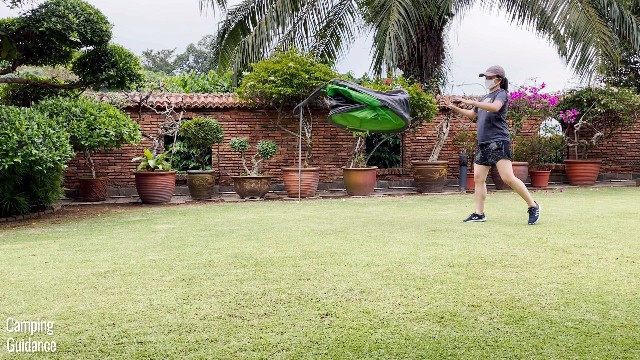
Your pop up tent will take all of 5 seconds to pop up, and will look something like this:
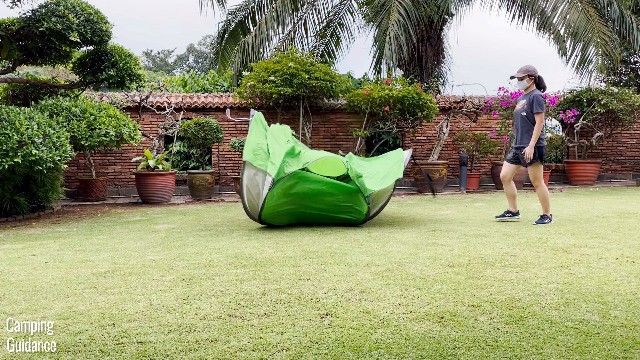
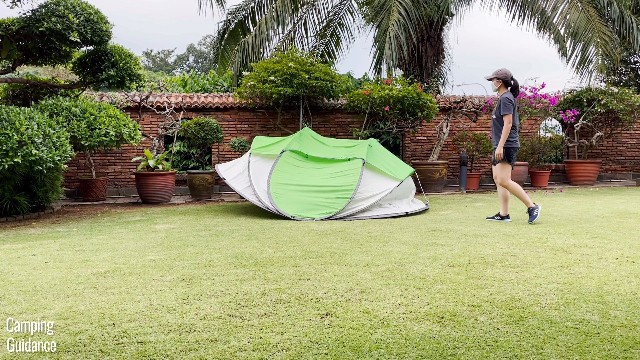
The reason pop up tents set up so quickly is because all the poles are pre-attached, and the rainfly is usually pre-attached as well.
If you decide to stake down and guy out your entire pop up tent, it’ll take only an additional 1-2 minutes or so, depending on the number of stake loops and guylines that your pop up tent has.
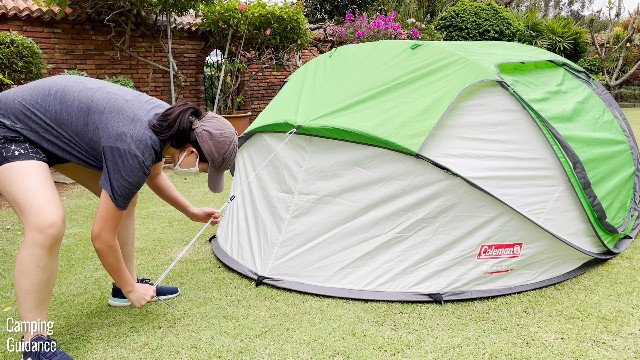
When I tested my 7 best pop up tents for camping, I looked at 2 different timings for the set up of each pop up tent:
- Pop up timing: How long it takes the tent to pop up, without staking and guying.
- Full set up timing: This is the pop up timing, with full staking down and guying down.
| Pop Up Tent | Name | Pop Up Timing | Full Set Up Timing |
|---|---|---|---|
 |
Coleman 2-Person Pop Up Tent | 0.25 minutes | 1.5 minutes |
 |
Coleman 4-Person Pop Up Tent | 0.25 minutes | 1.5 minutes |
 |
Quechua 2 Seconds 2-Person Tent | 0.5 minutes | 2.5 minutes |
 |
Fresh and Black 2-Person Tent | 1 minute | 3 minutes |
 |
Fresh and Black 3-Person Tent | 1 minute | 3.5 minutes |
 |
Teton Sports 1-Person Vista Quick Tent | 1.25 minutes | 2.75 minutes |
 |
Teton Sports 2-Person Vista Quick Tent | 2 minutes | 3.5 minutes |
Notice that each of my 7 pop up tents takes between 15 seconds to 2 minutes to set up. Including staking and guying out the entire tent, each of them takes between just 1.5 to 3.5 minutes, which is incredible.
Related Reading: How to Set Up a Pop Up Tent: 9 Steps + Real Pictures
Related Reading: Are Pop Up Tents Easy to Set Up and Fold Up?
Regular Tent Set Up
In contrast, a regular tent takes anywhere between 2-4 times the amount of time to set up. This is mainly because the poles are not pre-attached, which poses a couple of problems.
First, you would have to figure out which pole goes where. If the poles are not color-coded, you might attach the wrong pole to the wrong place. Also, the more poles you have to assemble, the higher the likelihood of you making a mistake.

Second, even if you figure out the right way to assemble the poles, you’d have to deal with pole sleeves. Sometimes, if a tent is designed well, the pole sleeves will be short and snag-free. But if you happen to get a less expensive and less well designed tent, the pole sleeves can be super long and annoyingly snaggy.
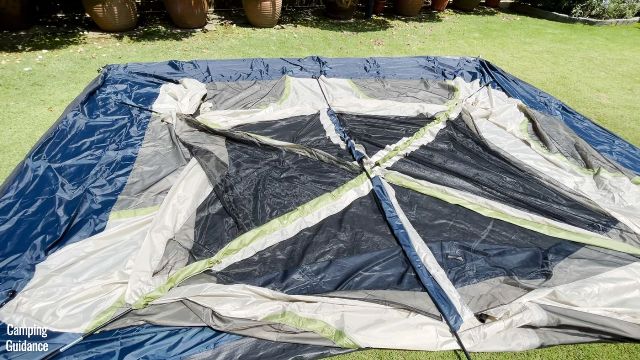
After all the poles are in place, you would then have to prop all the poles up on your own, which will also take some time. Then, you’d have to deal with the rainfly, which is not pre-attached (unlike pop up tents).
This can be a little annoying as well. Sometimes, rainflies are not color-coded, so you may put them on the wrong way, and this can add to your frustration and of course, your set up timing.
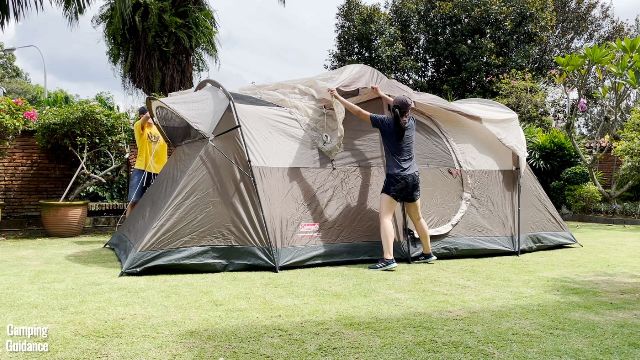
All that being said, how long does it usually take to set up regular tents? Well, here’s a table of some Coleman tents in different tent capacities, along with the full set up timing (1-person set up):
| Regular Tent | Full Set Up Timing |
|---|---|
| Coleman Sundome 2-Person Tent | 7 minutes |
| Coleman Sundome 4-Person Tent | 9 minutes |
| Coleman Sundome 6-Person Tent | 11.5 minutes |
| Coleman Montana 8-Person Tent | 22 minutes |
| Coleman WeatherMaster 10-Person Tent | 19 minutes |
Compared to a pop up tent with the same tent capacity, notice that the regular tents take about 2-4 times longer to set up. For example, the Coleman 2-Person Pop Up Tent took me 1.5 minutes to set up, while the Coleman Sundome 2-Person Tent took me 7 minutes to set up (more than 4 times longer).
2. Pack Up Timing
Similarly to the ease of set up, pop up tents also pack up much more quickly than regular tents.
Pop Up Tent Pack Up
To pack up a pop up tent, all you would have to do is to remove all the stakes and guylines, and then fold up the pop up tent.

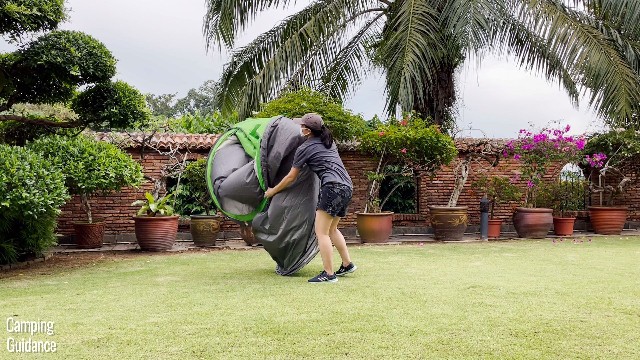
There’s no need to remove any of the poles, and there’s also usually no need to remove the rainfly. This really decreases the pack up timing of pop up tents.
For the ease of pack up, I also looked at 2 different timings:
- Pack up timing: How long it takes to pack up, without staking.
- Full pack up timing: This is the pack up timing, with full staking down and guying down.
| Pop Up Tent | Name | Pack Up Timing | Full Pack Up |
|---|---|---|---|
 |
Coleman 2-Person Pop Up Tent | 1 minute | 1.75 minutes |
 |
Coleman 4-Person Pop Up Tent | 1.25 minutes | 2 minutes |
 |
Quechua 2 Seconds 2-Person Tent | 2 minutes | 2.5 minutes |
 |
Teton Sports 1-Person Vista Quick Tent | 2 minutes | 2.5 minutes |
 |
Teton Sports 2-Person Vista Quick Tent | 2.5 minutes | 3 minutes |
 |
Fresh and Black 2-Person Tent | 2.5 minutes | 3 minutes |
 |
Fresh and Black 3-Person Tent | 3 minutes | 3.5 minutes |
Again, notice that each of my 7 pop up tents takes between 1.75 to 3.5 minutes to fully take down the entire pop up tent, and pack it back into the carry bag. If you decide not to use the stakes and guylines, you can save yourself an additional 30 to 45 seconds. Again, these pack up timings are incredible.
Related Reading: How to Fold Up a Pop Up Tent: 9 Steps + Real Pictures
One more fantastic advantage of a pop up tent when it comes to the pack up is this – the folded pop up tent will always fit perfectly back into the carry bag. There’ll be no more headaches on trying to get a mountain of tent gear back into a tiny carry bag.

Regular Tent Pack Up
On the other hand, when packing up a regular tent, after removing the stakes and guylines, you’d first have to remove the rainfly from the top of the tent.

Then, you’d have to remove all the poles from the pole joints and the pin and ring system, and break them down until they can fit back into the pole carry case (this is usually a separate carry case from the entire tent carry case).
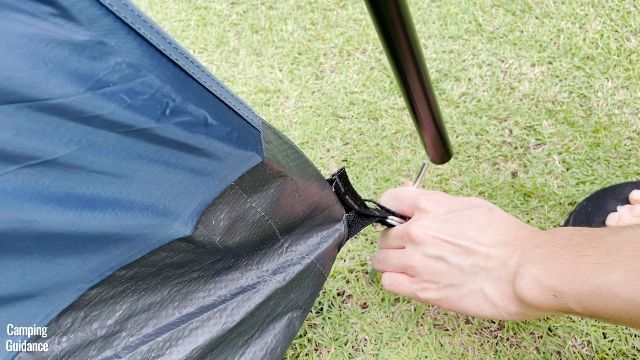
After that, you’d have to fold up the rainfly as well as the entire tent body. Then, you’d have to squeeze everything (rainfly, tent body, poles, stakes, accessories like gear lofts) back into a carry bag, which is usually not quite big enough.
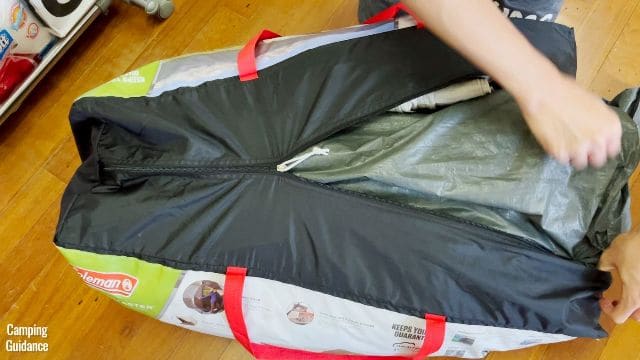
This usually requires a lot of struggling, squeezing, and huffing and puffing. All that being said, how long does it usually take to pack up regular tents? Again, here’s a table of some Coleman tents in different tent capacities, along with the full pack up timing (1-person set up):
| Regular Tent | Full Pack Up Timing |
|---|---|
| Coleman Sundome 2-Person Tent | 6 minutes |
| Coleman Sundome 4-Person Tent | 8 minutes |
| Coleman Sundome 6-Person Tent | 10 minutes |
| Coleman Montana 8-Person Tent | 14.5 minutes |
| Coleman WeatherMaster 10-Person Tent | 16 minutes |
Compared to a pop up tent with the same tent capacity, notice that the regular tents take about 2-4 times longer to pack up. For example:
- The Coleman 2-Person Pop Up Tent took me 1.75 minutes to pack up, while the Coleman Sundome 2-Person Tent took me 6 minutes (more than 3 times longer).
- The Coleman 4-Person Pop Up Tent took me 2 minutes to pack up, while the Coleman Sundome 4-Person Tent took me 8 minutes (4 times longer).
3. Packed Size
Since the poles of pop up tents cannot be removed like regular tents, there’s a limit to how much they can be bent when folding up. As such, the packed size of pop up tents will always be much bigger than a regular tent.
Packed Size of a Pop Up Tent
There are 2 different packed sizes of a pop up tent. One is circular, and the other is rectangular.
Circular packed sizes tend to be bulkier, more difficult to store in a car, and also more difficult to store at home. Check out how big my Coleman 4-Person Pop Up Tent is:
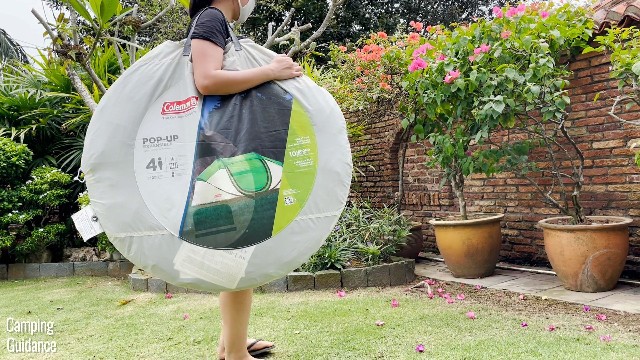
On the other hand, rectangular packed sizes tend to be easier to bring around, sling over your shoulder, and also store at home. These packed sizes tend to be smaller, and is my packed size of choice.

Of my 7 pop up tents, 5 of them have circular packed sizes (the more common shape), and only 2 of them have rectangular packed sizes. Check out this picture of all my pop up tents:

Here’s a table of the packed sizes of all my pop up tents as well, from the smallest to the largest:
| Pop Up Tent | Packed Size |
|---|---|
| Teton Sports 1-Person Quick Tent | 28 x 9 x 5 inches |
| Teton Sports 2-Person Quick Tent | 33 x 8 x 8 inches |
| Coleman 2-Person Pop Up Tent | 29 x 29 x 3 inches |
| Quechua 2 Seconds 2-Person Tent | 26 x 26 x 6 inches |
| Fresh and Black 2-Person Tent | 27 x 27 x 6 inches |
| Coleman 4-Person Pop Up Tent | 36 x 36 x 5 inches |
| Fresh and Black 3-Person Tent | 31 x 31 x 8 inches |
Notice that my Teton Sports Vista Quick Tents, which are rectangular in shape, are the smallest, while the other 5 circular pop up tents are larger.
Related Reading: Can You Backpack with a Pop Up Tent?
Packed Size of a Regular Tent
In contrast, the packed size of a regular tent is much smaller. Because the poles can be removed entirely, you can easily fold up the poles just by following the shock cording. This makes the packed size of regular tents much smaller.

In fact, let me show you a few pictures of the packed size difference between regular tents and pop up tents. Here is a rectangular 2-person pop up tent (Teton Sports, yellow) beside a 2-person regular tent (Coleman Sundome, black):

And here is a circular 2-person pop up tent (Quechua 2 Seconds, green) beside a 2-person regular tent (Coleman Sundome, black):
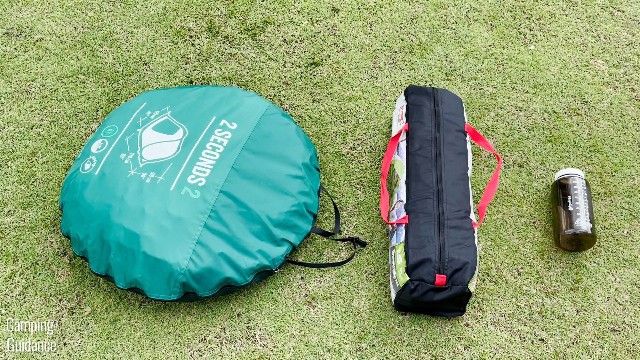
Here’s a table comparing various 2-person pop up tents against one of the most popular 2-person regular tents in the market (the Coleman 2-Person Sundome Tent):
| Tent | Packed Size | Packed Volume | Size Difference |
|---|---|---|---|
| Coleman 2-Person Sundome (Regular) | 23 x 8.5 x 6 inches | 1,173 cubic inches | 0% |
| Teton Sports 2-Person Quick Tent | 33 x 8 x 8 inches | 2,112 cubic inches | 80% |
| Coleman 2-Person Pop Up Tent | 29 x 29 x 3 inches | 2,523 cubic inches | 115% |
| Quechua 2-Person Pop Up Tent | 26 x 26 x 6 inches | 4,056 cubic inches | 246% |
| Fresh and Black 2-Person Pop Up Tent | 27 x 27 x 6 inches | 4,374 cubic inches | 273% |
The first tent is a regular tent, the next 4 tents are pop up tents. Notice that the packed size difference of a pop up tent ranges from 1.8 to 3.7 times (80%-273%) as large as a regular tent.
4. Durability
Compared to a regular tent, the lifespan of a pop up tent tends to be a little shorter, as there isn’t as much durability. This is because the poles of a pop up tent tend to be made of thin fiberglass that are constantly subjected to high pole tension. Let’s go through these points:
- Pole material;
- Pole thickness;
- Pole tension;
- Lifespan; and
- Pole replacement.
Regular Tent Poles
Regular camping tents have poles that are generally made of fiberglass, aluminum, or steel. Fiberglass is the least durable and most prone to breaking, while aluminum and steel (being metals) are much more durable. Also, the thicker the tent poles, the more durable they are likely to be.
Over the past few years of camping, I’ve found that my more durable camping tents tend to have poles made of steel, which are pretty thick.

Poles of a Pop Up Tent
In contrast, camping pop up tents are always made of fiberglass (never aluminum or steel). Also, the fiberglass poles are generally very thin.
As pop up tents need to be folded down easily, the poles need to be as flexible as possible. As such, they need to be made of the most flexible material, which is fiberglass. Also, the thinner the fiberglass pole, the more flexible it will be.
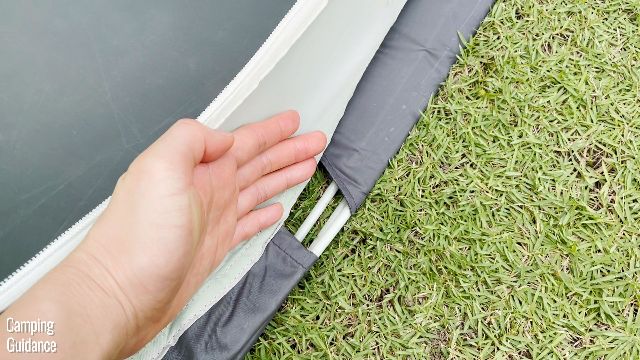
These thin fiberglass poles are usually the first thing to break in a pop up tent. This gives pop up tents slightly less durability than regular camping tents.
High Pole Tension of Pop Up Tents
Do you know what gives pop up tents their iconic “pop up” motion? It’s pole tension.
When you fold the poles up, the poles store a lot of tension, which is why you have to hold the poles together which a strap. This strap stops the poles from popping up:

However, this means that at any time when the poles are stored, there’s already a lot of tension on them. It also means that the poles have to be subjected to an enormous release of pole tension when popping up, which can take its toll on the poles:
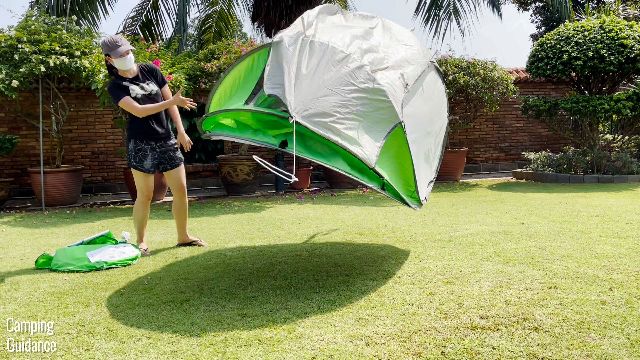
Pop Up Tent vs. Regular Tent Lifespan
Pop up tents can usually last anywhere between 3 to 7 years, while regular camping tents tend to last longer, anywhere between 5 to 10 years.
A couple of my camping tents (not pop up) have been with me for over 5 years, and are still going strong. My oldest pop up tent (the Quechua 2 Seconds Fresh and Black) has been with me for about 4 years, and on my last use of it, one of the poles popped out of the joint.

This is probably because there was too much pole tension for the joints. Thankfully though, I was able to fix it, by simply popping it back into the joint. So, my tent is definitely still usable, but I think it’s only a matter of time before it starts giving way.
Pole Replacement
Unfortunately, unlike regular tents where a broken pole can be easily replaced with another pole, because these poles are separate from the tent body, pop up tents usually have poles that are embedded within extremely long pole sleeves, making it ridiculously difficult to replace with another pole.
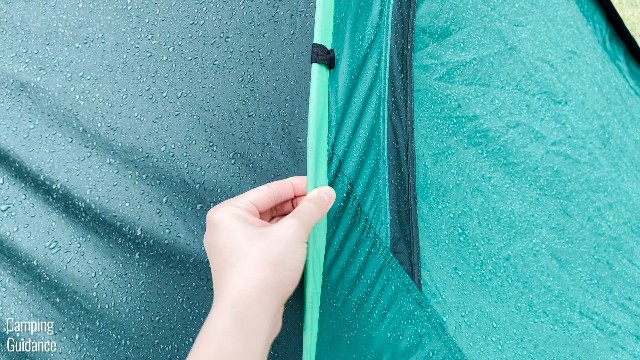
Because poles of pop up tents cannot be easily replaced, this is another reason why the lifespan and durability of pop up tents tend to be shorter than regular tents.
Related Reading: How Long Do Pop Up Tents Last? (With Real Pictures!)
Related Reading: Do Pop Up Tents Have Poles?
Related Reading: What Are Pop Up Tents Made Of?
5. Wind Protection
Regular tents are usually able to stand up to much stronger wind, such as wind blowing at 30 to 50 miles per hour. In contrast, pop up tents can take much less wind, such as wind blowing at 20 to 30 miles per hour.
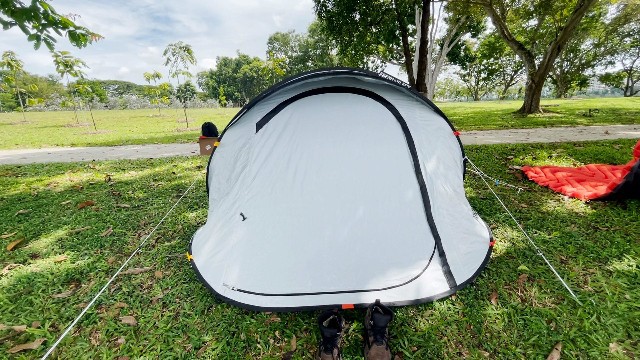
Wind protection is typically influenced by a number of factors, such as the:
- Pole thickness: Thicker poles are sturdier than thinner poles.
- Pole material: Aluminum and steel are sturdier than fiberglass.
- Pole structure: Criss-cross structures tend to be more stable than simple structures.
This is where regular tents and pop up tents differ. Other factors like the strength of the stakes, number of guylines and shape of the tent play less of an importance here when it comes to differentiating pop up and regular tents.

Wind Protection of a Regular Tent
Extremely wind resistant regular tents will have the following features:
- Aluminum poles;
- Thick poles;
- Multiple poles (not just your simple dome-shaped tent, which intersects only once at the top of the tent);
- Dome shaped;
- Many guylines; and
- Heavy duty stakes.
These tents tend to be used for windy conditions, like mountaineering. For example, do check out the REI Co-Op Base Camp Tent. Notice that the poles are thick, made of aluminum, and intersects multiple times across the entire tent for greater stability.
Wind Protection of a Pop Up Tent
Pop up tents are not known to be good in wind; these tents are manufactured for their ease of set up and take down, not so much for withstanding strong winds and inclement weather.
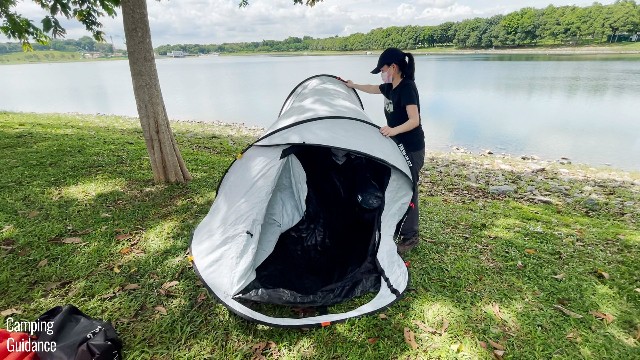
To give pop up tents their iconic “pop up” motion, in which they pop open the moment you take them out of their carry case, the pop up tents need to be made of fiberglass poles, which is the most flexible material that tent poles are made of. And not just regular fiberglass poles, but thin fiberglass poles.
The combination of the fiberglass material and thickness makes these poles very susceptible to bowing and flexing in strong wind.
Related Reading: Are Pop Up Tents Good in Wind? (What you Need to Know)
6. Ventilation
To cater to a pop up tent’s ease of set up, the rainfly of a pop up tent is usually almost always pre-attached. For some pop up tents, these rainflies might be full-coverage, and non-removable. Coupled with the lack of vents, ventilation can be a big issue for some pop up tents.
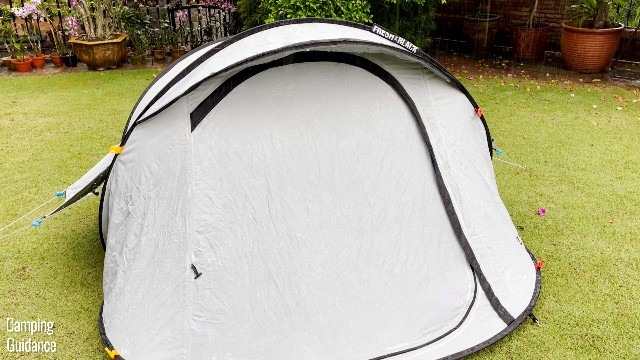
On the other hand, for regular tents, you’d always have to drape the rainfly over the tent on your own, so you will have the versatility of being able to take it off whenever you want to.
Ventilation of a Pop Up Tent
While not all pop up tents suffer from a ventilation problem, a couple of my pop up tents had this issue. The best example I have is the Quechua 2 Seconds Tent.
This pop up tent only has 1 rear vent that’s got to be guyed out, and it’s super tiny:
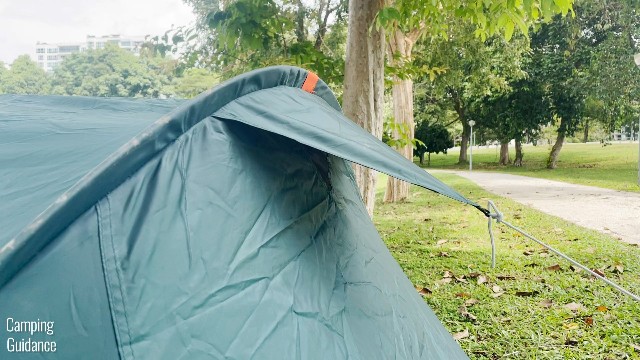
Apart from this tiny rear vent, and a few tiny spaces in the rainfly (less than a few inches long), there’s actually hardly any mesh and openings from the inside of the Quechua 2 Seconds Tent:

As such, when I slept in this Quechua 2 Seconds Tent overnight, with the door and window closed, the full coverage non-removable rainfly and the lack of vents made the inside stuffier than the outside.
When I woke up the next morning, the walls of the Quechua tent were completely dry, but I did notice a few drops of condensation on the roof of the tent.

Ventilation of a Regular Tent
In contrast, the rainfly of a regular tent is always removable. If there’s ceiling mesh (and there usually is at least some ceiling mesh), you’ll get lots of breathability, circulation and also opportunities for stargazing:

7. Tent Capacity
I also noticed that pop up tents usually aren’t available in very large tent capacities. This is because tents with much larger capacities are going to be extremely difficult to fold down, due to you having to fight the tension of the poles.
Pop Up Tent Capacity
The largest pop up tent that I have is the Coleman 4-Person Pop Up Tent, which isn’t exactly a 4-person tent, but more of a 3+ person tent. I could fit only 3 sleeping pads inside the tent, not 4:

Even at this 4-person capacity, when I was folding down the 4-Person Pop Up Tent by standing it up on one end, it was so much taller than me:

I definitely can’t imagine trying to fold down a 10-person tent in this way.
Regular Tent Capacity
On the other hand, regular tents are available in extremely large capacities, up to 16-people tents. (At least, that’s the largest tent I’ve seen so far.)
Personally, my biggest tent is a 10-person tent, which to me feels extremely large, and has more than enough space for my entire family:
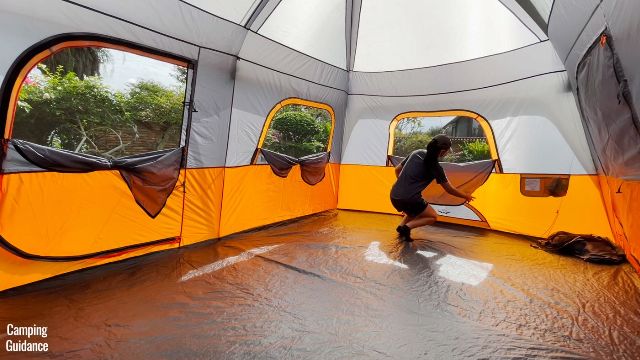
Regular tents can come in such large capacities because there’s no pole tension to fight against when packing it up.
Related Reading: I Bought & Tested the 6 Best 10-PERSON Tents!
Related Reading: How Big Are Pop Up Tents?
8. Ease of Cleaning
The ease of cleaning is perhaps one of the most overlooked factors when it comes to pop up tents. While many people always talk about the ease of set up and ease of pack up, not many people realize that ease of cleaning is quite important too.
Cleaning a Pop Up Tent
Because all the poles of the pop up tents are pre-attached, they cannot be removed by any means. This makes pop up tents retain their dome shape at all times; they cannot be folded over like normal tents for an easy cleaning of their base:

Cleaning a Regular Tent
In contrast, with regular tents, I can just remove the poles, fold the tent body over, and easily wash the base area with a hose or wipe it down with a wet cloth, like this:

Definition of a Pop Up Tent
A pop up tent is a tent that literally pops open out of the carry bag. All you have to do to set up the tent is to take it out of the carry case, remove the strap holding the tent together, and you’ll have yourself an almost fully set up, freestanding tent. This is the most common definition of a pop up tent.
While a pop up tent always has pre-attached poles and pole clips, different pop up tents may or may not have pre-attached rainflies and guylines.
For example, though my Teton Sports Vista Quick Tents have pre-attached poles that are attached by way of pre-attached pole clips, it doesn’t have a pre-attached rainfly. The pre-attached poles are black in color, and so are the pole clips.

Pros and Cons of a Pop Up Tent
Here’s a quick summary of the pros and cons of a pop up tent, based on all the points that I mentioned above:
Related Reading: 16 Pros and Cons of Pop Up Tents (From 3 Years’ of Experience!)
Definition of a Regular Tent
A regular tent (for the purposes of this blog post) is a tent without any pre-attached poles. So, to set up a regular tent, you’d have to first insert the poles through the pole sleeves, before you can prop the poles up for the tent body.
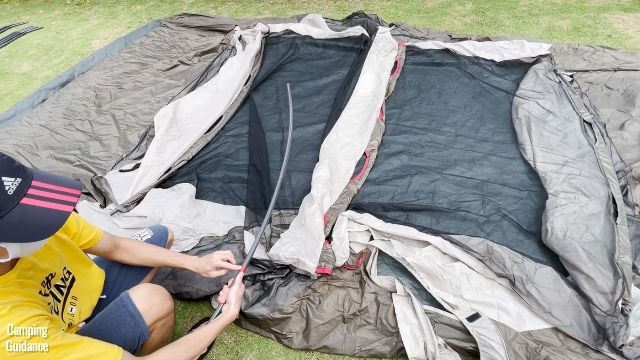
After that, you’re likely to have to clip the pole clips onto the poles manually, then drape the rainfly over the tent manually as well.

Pros and Cons of a Regular Tent
Here’s a quick summary of the pros and cons of a regular tent, compared to a pop up tent, based on all the points that I mentioned above:
Summary
Here’s a quick summary between a Coleman 2-Person Pop Up Tent, as well as a Coleman 2-Person Sundome Tent. All in the info gathered in the table are based on my personal measurements and testing of these 2 tents:
| Feature | Coleman 2-Person Pop Up Tent | Coleman 2-Person Sundome Tent |
|---|---|---|
| Set Up | 1.5 minutes | 7 minutes |
| Pack Up | 1.75 minutes | 6 minutes |
| Peak Height | 32.5 inches | TBA |
| Base Dimensions | 91 by 54 inches | TBA |
| Rain Test | Minimal Waterproofing | Moderate Waterproofing |
| Wind Protection | Minimal Wind Resistance | Moderate Waterproofing |
| Tent Material | 185T 68D Polyester | TBA |
| Rainfly Material | 185T 68D Polyester | TBA |
| Flooring Material | 185T 68D Polyester | TBA |
| Pole Material | Fiberglass | Fiberglass |
| Pole Thickness | TBA | TBA |
| Weight | 6.6 pounds | TBA |
| Packed Size | 29 by 29 by 3 inches | TBA |
| Price I Paid | $55 | $50 |
Here are my observations:
- Ease of use (set up and pack up): Pop up tent is ~3 times faster than regular tent.
- Spaciousness (peak height and dimensions): TBA
- Weatherproofing (rain and wind): Regular tents are usually better at wind protection, but not always better at rain protection. (The Coleman Pop Up Tent just has exceptionally minimal rain resistance, but the rest of my pop up tents had much better rain resistance.)
- Pole thickness: TBA
- Quality (materials used): TBA
- Portability (weight and packed size): TBA
- Cost: About the same price. I bought them at different times.
Ultimately, whether you should buy a pop up tent over a regular tent depends on your needs. If you prioritize speed and user-friendliness, and don’t intend to camp in inclement weather, a pop up tent will suit your needs perfectly.
To find out which pop up tent best suits your needs, check out this blog post where I bought, tested and thoroughly compared 7 of the best pop up tents in the market.

| Pop Up Tent | Full Review | Check Price |
|---|---|---|
| Teton Sports 2-Person Vista Quick Tent | Read Review | Amazon |
| Teton Sports 1-Person Vista Quick Tent | Read Review | Amazon |
| Coleman 4-Person Pop Up Tent | Read Review | Amazon |
| Coleman 2-Person Pop Up Tent | Read Review | Amazon |
| Quechua 2 Seconds 2-Person Tent | Read Review | Decathlon |
| Quechua 2 Seconds Fresh and Black 2-Person Tent | Read Review | Decathlon |
| Quechua 2 Seconds Fresh and Black 3-Person Tent | Read Review | Decathlon |
All My Pop Up Tent Resources:




